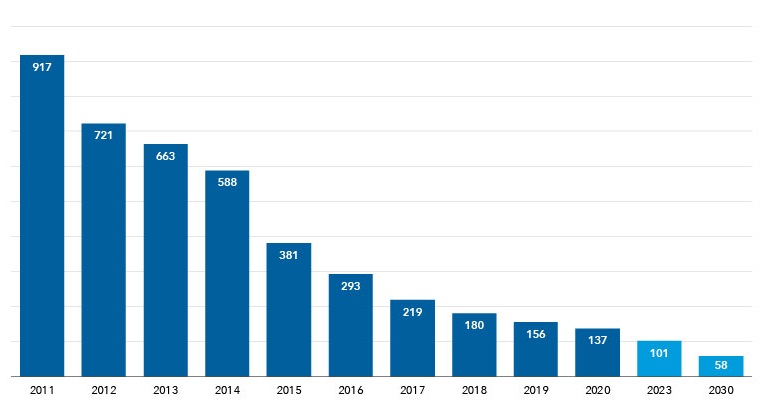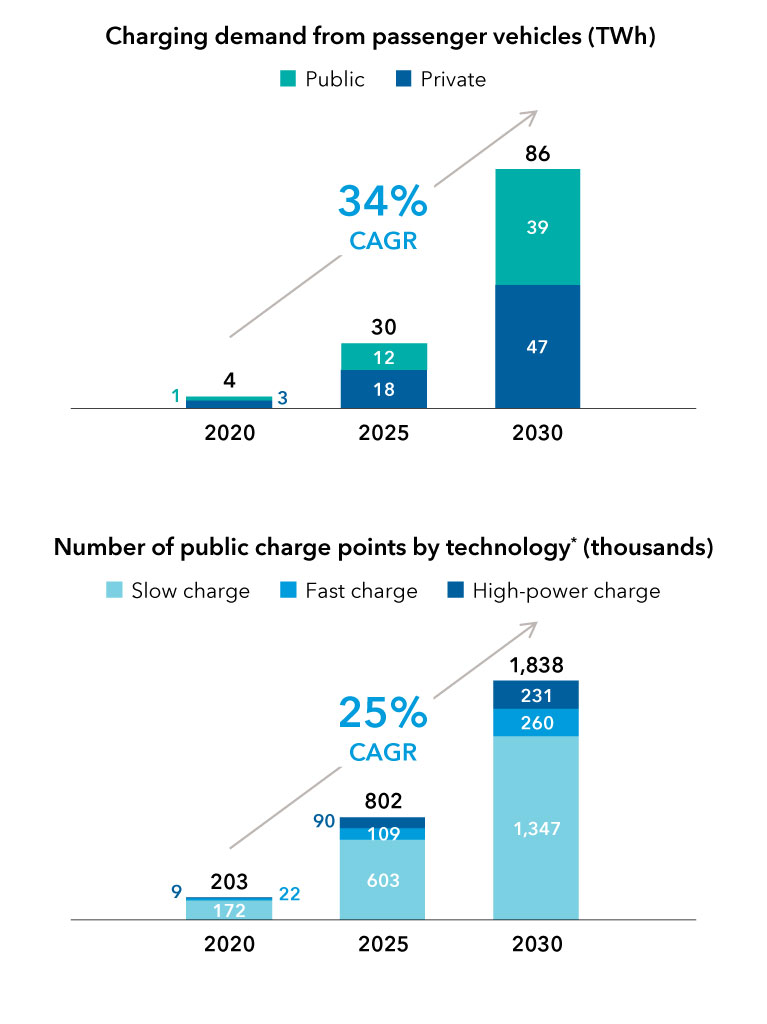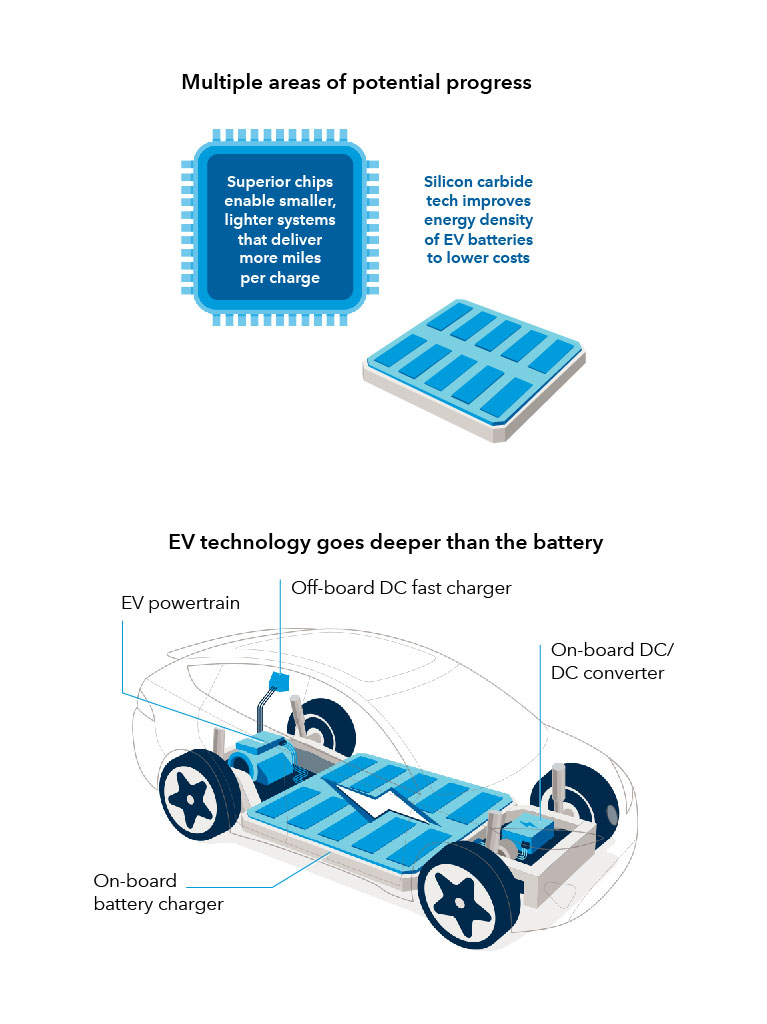ESG
15 MIN ARTICLE
Electric vehicles (EVs) are an important step toward reducing carbon emissions and their impact on climate change and the air we breathe. How far has the industry come – and how far does it have to go – to make electric vehicles profitable and sustainable?
KEY TAKEAWAYS
- Electric vehicles (EVs) are on the threshold of profitability. Battery costs are falling, and innovation is expected to offset higher raw materials costs.
- Challenges remain. The current shortage of chips could be a sign of future bottlenecks for new supply chains, while strategic investment is required to enable a sustainable charging network.
- Traditional car companies are starting to ramp up EV production, but they have a long way to go before they can compete with established companies such as Tesla.
What has driven the recent acceleration in electric vehicle sales?
Jason Zhang: The acceleration has been largely driven by regulations and incentives in Europe and China. In Europe, for example, 2020 was the first year when automakers faced stringent emissions regulations, which incentivized them to increase EV production and sales. Additionally, multiple European governments have introduced larger purchasing subsidies on EVs as part of broader stimulus packages to rescue their economies from the pandemic. EV penetration in Europe more than quadrupled from 2019 to 2021, surging from 4% to 20% in 2021, while in China it tripled from 5% to 15%. While the U.S. continues to lag with a penetration level of about 5%, regulations are coming. By 2030, EV penetration levels are expected to be around 60% to 70% in Europe and China, respectively, and roughly 50% in the U.S.
Danny Jacobs: In Europe, the premium segment has largely driven sales. Early adopters have been those who can afford the higher upfront cost of an EV and often have access to another car. However, the buyer base is broadening as prices come down, the charging infrastructure improves, and choice expands, particularly in popular segments like SUVs. The key to cracking mass market adoption of EV is for the industry to create an EV that is as cheap and convenient to own and operate as traditional ICE (internal combustion engine) vehicles. While the industry is getting there, it has yet to fully meet this challenge.
Are we nearing the point where EVs are as cheap as traditional vehicles?
Jason Zhang: The cost of batteries is the reason that EVs continue to be more expensive than ICE cars. There has been good progress on reducing battery costs, which have fallen over the last decade, although rising raw material prices have limited progress more recently. Nevertheless, by 2025, we could reach a level where a compact EV will be on a cost parity with a comparative ICE vehicle. Mini EVs with small battery packs are already becoming economical. In China, for example, the best-selling EV is the Wuling Hongguang MINI, which sold around 400,000 units in 2021. 1 While it has a battery pack of only 10 kilowatt hours (kWh) compared to the Tesla Model 3’s 60 kWh, the overall cost of the battery is only about US$1,500. This means the car can retail for about US$5,000 plus subsidies, which is already cheaper than the comparable ICE car.
Piyada Phanaphat: Rising raw material costs have slowed down the pace of reduction in battery costs as lithium, cobalt and nickel prices have surged. However, innovation could help to offset these higher costs. China has diversified from using only NCM (nickel cobalt manganese) batteries, reverting back to LFP (lithium iron phosphate) batteries that now command more than half of the market due to their lower costs. While LFP batteries have inferior range, their cost advantage has allowed for a new entry-level battery.
Reducing battery costs should make EVs more affordable
Lithium-ion battery pack costs (per kilowatt hour, USD)

Forecasts shown for illustrative purposes only.
Sources: Bloomberg New Energy Finance, Statista. 2023 and 2030 are forecasts as of December 31, 2020.
Danny Jacobs: There are concerns that the recent shortage in semiconductors may prove to be the first in a series of bottlenecks as EV makers ramp up production. Automakers have responded to the chip shortage by trying to vertically integrate or secure supply via partnerships. Management of the supply chain and ensuring access to the resources needed will be crucial for car companies in the coming years.
Will the availability of charging networks become a limiting factor?
Julie Dickson: The demand for EV charging points is likely to outstrip supply as an increasing number of people own EVs. Additionally, we also need to consider the impact of that additional demand on the electrical supply and the grant capacity. Governments need to work closely with utilities and auto manufacturers to create a charging network that is fit for purpose. Tesla, for example, has a fully integrated process where they offer both supply and charging points alongside actual EVs. Utilities need to develop a strategic plan to allow and enable greater electricity supply and distribution, as well as the ability for cars to be charged in different places. We need slower charging points in or near home or during the day at work and faster charging points on the road network. We also need to educate EV owners on the best times to charge vehicles to avoid exacerbating demand at peak times for electrical supply.
Demand growth for EVs may outstrip supply of charging stations
Europe’s projected EV charging demand over the next decade

Forecasts shown for illustrative purposes only.
Source: BCG EV forecast, 2021; BCG analysis. *Public slow chargers are under 22kW, while public fast chargers are between 22kW and 149kW; public high-power chargers are more than 149kW.
CAGR: compound annual growth rate. TWh: terawatt hour
EVs can play an important role in decarbonizing the world. What are the key ESG factors you consider when analyzing the industry?
Jason Zhang: EVs are automatically seen as being environmentally friendly, but that’s not always the case. Much depends on where the electricity comes from. In China, around 60% of electricity is generated from coal. 2 Also, the production of batteries is both material- and power-intensive. Sweden’s Northvolt has committed to using 100% locally sourced renewable energy in the production of its batteries and has promised that, by 2030, half of the materials used to produce new batteries will be sourced from recycling old batteries. 3 Raw material sourcing is also important. BMW has made a point to focus on sustainable and ethical mining to ensure workers have safe working conditions and are fairly compensated. Finally, there’s the social aspect of the transition from ICEs to EVs to consider. Many large auto manufacturers are huge employers but EV production is far less labor-intensive, so companies need to have a strategy to retrain workers as they transition to a smaller workforce.
Danny Jacobs: Another factor that could grow in prominence in the coming years is the safe deployment of autonomous driving software. We’ve already seen some differentiation in the approach being taken, and I expect this to become a more prominent ESG factor in the coming years.
How are traditional auto companies managing the transition to EVs?
Jason Zhang: The internal combustion engine is extremely complex: engines have different numbers of cylinders, different displacements that get mated with various types of transmissions and speeds. In contrast, EVs are simple mechanically with just a battery, electric motor, inverter and a one-speed transmission. This means the fixed cost for producing an EV is much lower than an ICE, making it easier to scale. However, EVs do require investment in software and electronic architecture. Traditional auto manufacturers are having to spend a lot of money on building their software expertise. While they have the advantage of the profits and cash flows that are generated from their ICE business, over time that may become more of a disadvantage due to the complexity of having to invest in both ICEs and EVs.
Danny Jacobs: Equity markets want auto companies to capture as much EV market share as they can. In contrast, credit markets are focusing on the need to maintain profitability and cash flows from existing ICE divisions during the transition to EVs to help maintain credit ratings. This situation is leading to some tension in the equity and credit component of auto companies.
What are your thoughts on Tesla?
Julie Dickson: Tesla has a first mover advantage and has been both nimble and successful in entering the high-end EV market. Its market cap of US$940 billion makes it the sixth largest company in the world, 4 giving it access to low cost of capital to allow it to build its operations. Another advantage is its connectivity: its software and battery operations management system allow its EVs to run efficiently and stay on the road longer. Moreover, Tesla does not just build cars; it is also involved in renewable energy, energy supply, battery manufacturing and energy storage. This integrated approach gives it a distinct advantage and helps it command a valuation premium. Whether it can sustain its significant market share as new entrants come in and traditional manufacturers transition into EVs will need watching. Profit margin growth will be key to valuations.
Danny Jacobs: One interesting observation is that Tesla only has four models, of which two are the cheaper versions of the others. The traditional auto sector suggests it is optimal to have a greater number of models, particularly in popular categories like SUVs. Take Volkswagen, for example. It produces the same skateboard EV architecture and then puts different bodies on top of it, which may play more to consumer preferences. It will be interesting to see if the limited number of models in Tesla’s lineup will limit its ability to sell to different areas of the market. Tesla’s current valuations imply that it will either achieve a market share we’ve never seen before or that making and selling electric cars will be a meaningfully more profitable and attractive proposition than the traditional car businesses.
Jason Zhang: Tesla currently has a meaningful lead in all areas of EVs. While traditional carmakers do have the ability to close the gap in terms of things like battery technology and electric drivetrain, Tesla’s leading software is more sustaining. Tesla pioneered a vertically integrated in-house approach to software and electronics. It’s one of the only automakers that designs its computing chips in-house. Instead of integrating software and ECUs (electronic control units) from different suppliers, which is what traditional automakers do, Tesla runs a centralized software stack that controls everything from infotainment and battery management to autonomous driving. This centralized computing model reduces complexity, increases functionality and allows Tesla to undertake over-the-air updates. It means a Tesla is a far more advanced, connected and innovative EV. While major traditional automakers are starting to switch to this model and are building their in-house software expertise, I am skeptical that they can do so until the middle of this decade. That’s the major reason I think Tesla’s tech and software advantages are sustainable.
Do you think tech companies will start to produce EVs?
Danny Jacobs: It looks like a number of companies, like Apple, Alphabet and Sony, may well soon enter the market. They could be looking to provide the software that underpins EVs; they aren’t likely building the vehicles themselves. However, given the number of car companies, both for ICE and EV, this is an industry structure that’s both suboptimal and unlikely to change. Therefore, these tech companies, many of which are used to dominating the industry in which they operate, may find the auto industry less appealing than their core markets.
Julie Dickson: I certainly think there’s an opportunity for tech companies to partner with manufacturers where quality software will become a differentiating factor. EVs that can offer a really good experience in a connected vehicle could be a very strong monetization hub for manufacturers.
Can you elaborate on the Chinese EV ecosystem?
Jason Zhang: China is the biggest auto market globally, both for ICEs and EVs. 5 Last year, more than three million EVs were sold in China, which was around half of all EV units sold globally. 6 While China has been trying to become a successful ICE manufacturer for decades, foreign brands make up a large portion of the Chinese market today. In contrast, Chinese brands have more than 80% of the EV market share, 7 driven by companies like BYD and Shanghai Auto as well as start-ups like NIO. Tesla is the only meaningful foreign EV brand in China; despite starting production in the country in 2019, it sold half a million units in 2021.8 Software connectivity is becoming increasingly important in the EV space in China, ensuring that the car always feels fresh with updated features. In my view, these attributes will also become more important to Western consumers.
Piyada Phanaphat: China encouraged the entire battery supply chain to be in China, from lithium to battery material to cell makers to equipment makers. As they shunned foreign competitors, the domestic ecosystem had time to mature. This has helped Chinese companies such as CATL, which is now the largest battery maker in the world. China is one of the earliest markets to be successful at entry-level EVs, city cars with relatively small ranges. Rapid innovation is set to continue and a new business model, based on battery pack change, means EV manufacturers can address consumer concerns about needing to find charging stations.
Rapid innovation is set to continue
Innovation can drive lower costs, improve EVs and overcome challenges around raw materials.

1. Source: Mark Kane. “China: Wuling Hong Guang MINI EV Sets Massive Sales Record.” Inside EVs, January 14, 2022.
2. Source: Muyu Xu and Shivani Singh. “China's Power Woes May Worsen as Demand Surges amid Coal Supply Lag.” Reuters, October 18, 2021.
3. Source: Northvolt.com. Accessed February 24, 2022.
4. As of January 31, 2022. Source: Morningstar.
5. Source: Statista, 2022.
6. Fred Lambert. "Global market share of electric cars more than doubled in 2021." electrek.com, February 2, 2022.
7. Source: Clemens Dabelstein et al. "Winning the Chinese BEV market: How leading international OEMs compete." McKinsey and Company, May 4, 2021.
8. Source: Fred Lambert. "Tesla announces new investment in Gigafactory Shanghai." electrek.com, February 23, 2022.
Related content
Green revolution will re-energize utility stocks
The future of ESG investing depends on deep analysis



